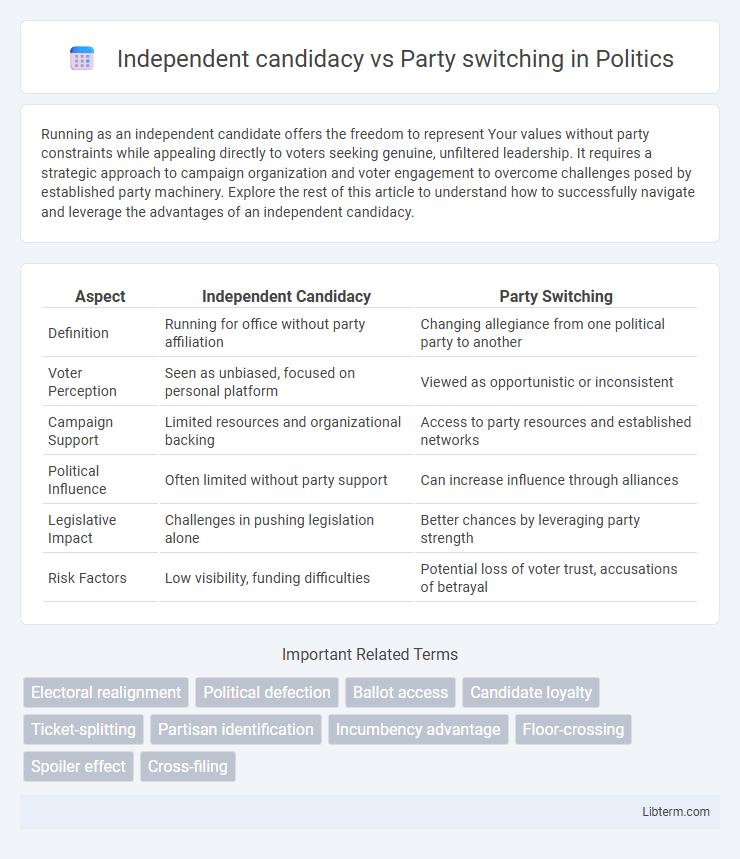Running as an independent candidate offers the freedom to represent Your values without party constraints while appealing directly to voters seeking genuine, unfiltered leadership. It requires a strategic approach to campaign organization and voter engagement to overcome challenges posed by established party machinery. Explore the rest of this article to understand how to successfully navigate and leverage the advantages of an independent candidacy.
Table of Comparison
| Aspect | Independent Candidacy | Party Switching |
|---|---|---|
| Definition | Running for office without party affiliation | Changing allegiance from one political party to another |
| Voter Perception | Seen as unbiased, focused on personal platform | Viewed as opportunistic or inconsistent |
| Campaign Support | Limited resources and organizational backing | Access to party resources and established networks |
| Political Influence | Often limited without party support | Can increase influence through alliances |
| Legislative Impact | Challenges in pushing legislation alone | Better chances by leveraging party strength |
| Risk Factors | Low visibility, funding difficulties | Potential loss of voter trust, accusations of betrayal |
Understanding Independent Candidacy
Understanding independent candidacy involves recognizing its emphasis on individual political identity outside traditional party structures, allowing candidates to appeal directly to voters without party constraints. Independent candidates often face challenges in ballot access, funding, and media coverage compared to party-affiliated contenders but benefit from greater flexibility in policy positions and campaign messaging. This form of candidacy highlights voter desire for alternatives to partisan politics and can influence electoral dynamics by attracting nonpartisan or dissatisfied voters.
What is Party Switching?
Party switching refers to the act of an elected official or politician changing their political party affiliation after being elected, often to align with shifting ideological views or strategic career goals. This behavior can influence legislative dynamics by altering party balance and affecting voter trust and perceptions of political stability. Unlike independent candidacy, where individuals run without party ties from the outset, party switching involves a change in loyalty during a political tenure.
Historical Overview of Both Paths
Independent candidacy traces back to early democratic movements where individuals sought to bypass established party systems to appeal directly to voters, often highlighting grassroots support and ideological purity. Party switching emerged prominently as politicians realigned their affiliations to better match shifting political landscapes, regional interests, or evolving personal convictions, evidenced by notable cases in US politics such as Strom Thurmond and Ronald Brownstein. Both paths reflect strategic responses to party dynamics, with independent runs challenging party dominance and party switching reshaping political coalitions over time.
Motivations Behind Running as an Independent
Candidates choose independent candidacy to avoid party constraints and present unique platforms that align more closely with voter interests, emphasizing personal values over party loyalty. Independent candidates aim to attract voters dissatisfied with traditional party politics, leveraging outsider status to highlight commitment to specific issues or reform. This path often reflects motivations such as seeking greater autonomy, responding to local concerns, or escaping internal party conflicts.
Reasons Politicians Switch Parties
Politicians often switch parties due to ideological shifts, seeking alignment with evolving personal beliefs or constituent priorities. Strategic considerations such as improving electoral chances or gaining access to party resources also drive party switching. Discontent with party leadership and internal conflicts frequently motivate independent candidacy or changing political affiliation.
Legal and Electoral Frameworks
Independent candidacy operates under legal frameworks that allow candidates to run without party affiliation, often requiring the collection of a specified number of signatures or meeting financial thresholds to qualify for ballots. Party switching is governed by electoral laws that regulate the timing and conditions under which elected officials can change party affiliation without losing their seats or triggering special elections. Both practices impact electoral dynamics by influencing candidate eligibility, voter choice, and the stability of party systems within jurisdictions.
Impact on Voter Perception
Independent candidacy often enhances voter perception by signaling political autonomy and a commitment to grassroots values, which can attract disillusioned voters seeking alternatives to party politics. Party switching may generate skepticism among constituents due to perceived opportunism or lack of ideological consistency, potentially eroding trust and voter loyalty. Studies indicate that voters prioritize authenticity and clear political identity, making independent candidacy a strategic advantage in cultivating positive voter engagement.
Campaign Strategies: Independents vs. Party Switchers
Independent candidates often emphasize grassroots mobilization and personalized voter outreach to compensate for the lack of established party infrastructure, tailoring messages to local concerns and fostering direct community engagement. Party switchers leverage their prior party affiliation and insider knowledge, aiming to realign their platforms with the new party's base while addressing voter skepticism through demonstrated policy consistency and strategic rebranding. Campaign strategies for both prioritize targeted communications and voter trust-building but differ sharply in resource access and brand loyalty dynamics.
Election Outcomes and Success Rates
Independent candidacy often faces lower success rates compared to party-affiliated candidates due to limited access to established voter bases and campaign resources. Party switching can improve election outcomes by aligning candidates with more popular or strategically advantageous parties, increasing voter support and fundraising capabilities. Studies show that candidates who switch to dominant parties tend to have higher chances of electoral victory than those running as independents.
Implications for Democratic Processes
Independent candidacy promotes diverse representation by allowing individuals to run without party constraints, potentially increasing voter choice and reducing partisan polarization. Party switching can disrupt party coherence and voter trust, raising concerns about political opportunism and weakening party accountability mechanisms. Both practices significantly influence democratic processes by shaping electoral behavior, party system stability, and the overall quality of democratic governance.
Independent candidacy Infographic

 libterm.com
libterm.com